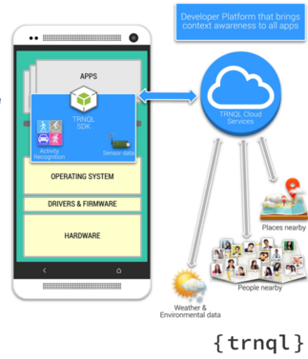
Developers want end users to engage with their applications, and a new way of trying to achieve that is having devices learn from the user and adjust accordingly. This capability has been seen in technologies such as Apple’s Siri, Google Now, IBM’s Watson, and Microsoft’s Project Adam, but has been mostly too complex and too time-consuming for smaller companies or independent developers to implement.
But one company wants to change that.
With its first release, trnql is designed to give developers the ability to add “contextual signals” to their applications. Contextual signals utilize a smartphone’s sensor to understand where a user is and what they are doing.
“Contextual signals help developers better understand the user, better understand why they are using the application, and better understand how users can get a better experience from it,” said Nazmul Idris, founder and CEO of trnql.
(Related: If computers only had a brain…)
Idris, a former senior developer advocate for Android developer relations at Google, left Google earlier this year to start trnql after hearing how developers struggled to bring contextual awareness to their applications.
“It’s great that Apple and Google are able to use context for Siri and Google Now, but why is it that most mobile apps are not providing a more contextual user experience through the use of real-time signals such as location, speed, weather, user activity, and a whole host of other available data?” he said. “Context is the killer app for killer apps, and we want to make it easy for developers to create contextually aware apps today—apps that are more useful, engaging, delightful and, ultimately, valuable for users.”
trnql has released the trnql platform, which aims to shave the time and complexity it takes developers to integrate contextual awareness into their Android, iOS and IoT applications. According to Idris, what used to take two to three months to integrate 50 to 60 different APIs now takes weeks, and it only involves integrating a single library that has access to the different APIs.
“It’s kind of hard to believe how simple we made it,” he said. “We wanted to make it available to a whole host of developers who might not have the resources or skills or expertise needed to do these deep integrations with these APIs.”
Idris sees these contextual signals being implemented in messaging apps, calendar apps, and a broad range of other applications that don’t exist yet. “Imagine you have a messaging app: One way to make [it] better is, let’s say, ‘I’m chatting with you, and you’re in the car.’ The message app should notify me that you are in the car and maybe I should call you,” he said. “Or let’s say I’m late for a meeting, and the phone senses I’m not moving. Maybe it should give me a more stern notification, or notify you that I am late.”
In addition, Idris said if an application can sense where the user is, or if there are other users nearby, it opens the possibility of new social apps that provide hyperlocal interactions with people.
Currently the platform enables applications to gain insight into what the user is doing, where they are, and what the weather is like. By the end of the month, Idris hopes to provide a smartplaces feature that gives developers point-of-interest data for where a user is. In addition, he has plans to launch a nearby feature that shows what or who is around the user.
Other features of the trnql platform include cloud services, an SDK, and a cloud-based developer dashboard to give developers insight into their analytics.
“To implement context, developers must use various third-party APIs, add configuration information for each of them, use different methods, add different libraries, and maintain different keys and tokens—and then maybe buy services from different price tiers. It’s incredibly complicated,” said Umar Farooque, a developer of Android and iOS apps. “trnql handles all of this complexity for me; now I just implement a single library that provides access to many different APIs. Even better, the methods/code part of the implementation is very simple. Using trnql has shaved about 25% to 30% off my development time, so I can spend more time on user experience and other aspects of my apps.”






